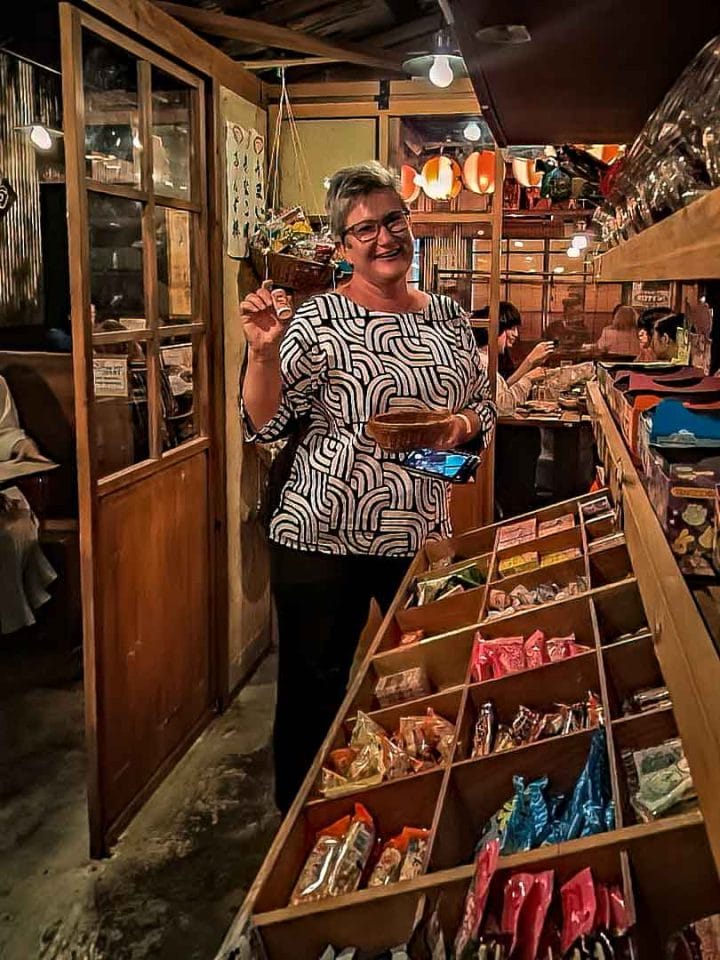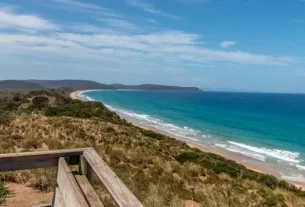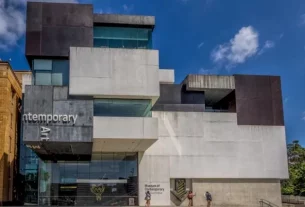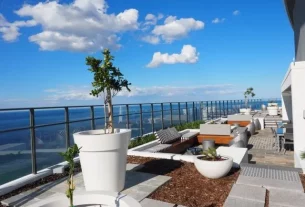Are you wondering if you should join a Shinjuku food tour? Food tours can be a great way to orientate yourself in a new city, you’ll find some hidden food spots and learn more about the food culture but like any tour they can be pricy so you want to be sure it’s something you will enjoy. In this review we take a closer look at the Magical Trip Shinjuku Food Tour, without giving away the real spoilers, so you can decide if this tour is for you.
We’ve done quite a few food tours in Tokyo at this point. While this was our first time with Magical trip in Tokyo, we have had a great time on our previous tours with them including my favourite Kyoto food tour through Gion at night. When we had the chance to join Megumi on the Shinjuku Food Tour on our recent spring trip we couldn’t wait.
Table of Contents
Magical Trip Shinjuku Foodie Tour
We’d travelled back from relative calm of Matsumoto that afternoon into the heart of Shinjuku on a Saturday evening, we were feeling the overwhelm. Someone else picking the dinner spots was going to be a big relief. Honestly, I wasn’t sure where to start as we were carried along by the surging evening crowds when we headed out from the hotel at around 5pm to orient ourselves around the station area.

In sharing our experience on the Shinjuku food tour, please note that the places we visited and the guides leading the tour will vary over time, we’re looking to give a glimpse into the experience here and our thoughts on it.
At 6pm we met our guide, Megami and the other couple who were joining the evening tour on the northwest side of Shinjuku station. From there we headed off to explore Kabukicho, the neon lit entertainment district on the ‘east side’ of Shinjuku station.
The evening is run as a type of progressive meal where you have a course at each of 3 stops. As a slower eater I found this worked really well for me giving time to eat and enjoy the atmosphere at each place. In between restaurants we got to walk off a little bit of the full feeling before we sat down to enjoy the next course and as we walked we found some hidden spots and saw some key areas of Shinjuku along the way that would help orientate us for the remainder of our stay.
Our first restaurant on the tour was a sushi restaurant but as we have come to expect from Magical Trip they have found something a little different. In this case it has an Edo theme with long wooden tables and bench seats. We’re shown to our seats and given a custom ‘Magical Trip’ collaboration menu to pick from.
I opt for the modern sushi board while Drew takes the more adventurous option including both modern and Edo period sushi options. It was a dish enjoyed by townspeople back in the day and the style resembles the nigiri sushi we know today made with formed vinegared rice and raw fish laid over the top but it is huge, a good 3 times the size of normal sushi!
There is also a soup, more hearty than the usual miso, served with vegetables and a thicker fish base. It tastes good, but I know better than to fill up on soup so early in the evening.
There are also options for vegetarians, those with a larger appetite, or those less interested in raw fish, including soba noodles and grilled eel.
As part of the tour, we choose from a good range of drinks, both alcoholic and non-alcoholic. Drew had a beer at this stop while I went with the momo chu, a peach Shoshu highball, which is very common in Japan. It’s alcoholic but this one is delicious and not too strong, at least it doesn’t taste too strong, they can have a bit of a kick.
We have around 45 minutes between finishing at our first stop and our second venue. During this interlude we are taken on a walking tour of the area. It’s a leisurely pace and there is plenty to see. We wander through the narrow lanes of Kabukicho where tiny doorways and narrow staircases lead into the hidden bars and izakaya hidden beyond, this part of town won’t come fully to life for a few hours yet but it will go through into the early hours of the morning.
We walk past the lineup of maids and others looking to attract tourists to their various bars and establishments. Honestly, most look bored or seriously unhappy to be there, and who can blame them? We spot Godzilla peeking out above the new Gracery Hotel and continue on to explore that newer addition to Shinjuku.
We are shown a spot to get an elevated view of Shinjuku that is both free and public access and yet we are the only ones there enjoying it. The city lights are mesmerizing below, but it is soon time to move on to the next part of our meal.
Another thing I really enjoy about doing a food tour early in our stay in an area is that as you discuss your food preferences and things you are interested in trying with your guide, they’ll often point out good and popular places to try something that you pass so you can head back there. There were a few places we passed during the evening that I mentally noted to find our way back to in the following days.
We were told that our second destination would be Japanese BBQ. We stop outside a specialty Wagyu restaurant. Again, it’s not somewhere we would have stumbled upon ourselves. It looks almost closed from the front, but as we make our way past the front counter and up the narrow staircase, it is clearly not.
Our table has been set aside for us, and we make our way to it directly. A gas BBQ plate is in the centre, and a series of plates and bowls are laid out. There is a menu specially prepared for Magical Trip, this time offering a selection of wagyu or a vegetarian option. I’m sure the vegetables are delicious, but the wagyu is calling, and it is what we all choose.
There is also a diverse drinks menu of beer, local wines, spirits, and soft drinks. Including a drink at each stop is a great feature of this tour. It does make it feel like an actual course of the meal that you are taking time to stop and appreciate rather than a tasting and racing off again.
The meal includes soup, rice, fresh salad, and pickles. Given what we have already eaten, we are given the option to skip the rice, and I enthusiastically welcome that choice. However, those with a larger appetite can have the full meal set.
The meat is clearly the star, and we each get to grill a piece of wagyu from 4 different cuts that offer a spectrum of flavour and fat marbling. This way, you get it cooked to your own liking, and with meat this good, it would be hard to go wrong unless you got distracted and overcooked it, but it is such a fun, interactive part of the meal that it is unlikely.
A unique aspect of this restaurant we enjoyed is that you have a salt ‘coaster’ or Himalayan salt block on which you rest the meat for 1-2 minutes after you remove it from the grill. This perfectly seasons the meat, but you can add wasabi or dip it in a teriyaki-like sauce if you want. I prefer resting on the salt block, but it is delicious with wasabi and sauce.
The Wagyu Olympics are run across Japan every five years to find the farm that supplies the best wagyu beef. In 2021, it was won by a farm in Kagoshima, at the very bottom of Kyushu, which supplies the beef to this restaurant. It was a great opportunity to try a Japanese BBQ restaurant with a Japanese-speaking guide.
For our final sweet course, we went to a dagashi izakaya—something new to us! Dagashi is penny candy; in Japan, they call it American candy. It’s the processed packaged kind rather than traditional Japanese confectionery called wagashi. An izakaya is a casual Japanese bar that typically also offers food.





Now I generally don’t eat processed sweets, artificial colouring and all that, so I might have expected to be a bit disappointed except that the place was absolutely oozing character and fun, you can’t help but get caught up in it. It is also fitting to end an evening in Shinjuku. Shinjuku is not traditional Japan; Kabukicho, in particular, clings closely to its Showa-era (post-war) roots and Americanisation. If you boil down Kabukicho and add a touch of whimsy, then this sweet izakaya is it.
The place has a post-war Tokyo vibe and themed decor. You are seated at a booth, order your drink, and then take your basket to load up on snacks. There are both savoury and sweet options, but I have to admit that at this stage, I spent most of my time rummaging through the sweet shelves and baskets, some unique others very nostalgic.
The drinks also fitted the era; I had a melon soda cocktail, and Drew tried Hoppy. It’s what Hoppy Street in Asakusa is named after, but we haven’t actually tried it before. Beer was almost impossible to get after the war and definitely not in the average budget, so Hoppy was created, a non-alcoholic carbonated drink that tasted slightly like beer; add a slug of sake (whatever potent spirit is available), and it’s the next best thing. It is definitely drinkable and worth a try when you have the chance, but that alcoholic melon soda I would order it again!
What we enjoyed most about the Magical Trip Shinjuku Food Tour
A great local guide.
Megami is from Western Japan but has lived in Tokyo for many years. She (or Magical Trip) clearly had a good relationship with each establishment we visited and shared interesting spots and information both during the meal and while walking between venues. The guide really does make or break a tour and, in our experience, Magical Trip have great people.
Small group.
The Magical Trip tours are small groups, which is important somewhere like Shinjuku, where you will need to move through the crowds, keep up with your guide and also want to hear what they are sharing about the area you are passing through.
I definitely also put a pin in Google Maps for a few of the spots she pointed out in passing so we could head back and try some of their dishes in the following days.
They carefully select and partner with each place you visit.
- The food and drinks were delicious and of good quality.
- They develop a menu and drinks list with each place you visit that is just for their tour so you get to choose what you want to eat and drink, of course your guide gives top pointers along the way.
- Each place had our table waiting for us on arrival, so our time in each place was maximised, and the evening felt full but not rushed.
Is the Shinjuku Food Tour good value?
We felt it was. We had a memorable evening and enjoyed all the different food and drink options. No food tour in Japan is inexpensive, but Magical Trip tours are often a little more affordable and are very well planned and executed.
Other Magical Trip food tours
This was the Shinjuku Foodie tour, which we thoroughly enjoyed, but if you aren’t staying in Tokyo, or Shinjuku is somewhere you already know pretty well, there are other good options to consider.
They run highly rated tours in Kyoto and Hiroshima. Or while in Tokyo, you might want to explore another tourist centre like Shibuya or the Tsukiji market or head somewhere slightly off the tourist path like the old town of Yanaka Ginza.



